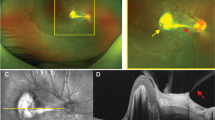Abstract
Purpose
To explore the clinical characteristics of patients with ocular toxocariasis in eastern China.
Methods
The medical records of 35 cases of ocular toxocariasis in Fudan University Eye & ENT Hospital between May 2009 and April 2011 were retrospectively reviewed and analyzed. UBM, RetCam or fundus imaging, and high-frequency or conventional ultrasonography were performed in these patients.
Results
The mean patient age in our series of ocular toxocariasis was 11.86 ± 8.80 years. There were 28 children and seven adults, the majority residing in a rural area (88.57%). All cases were classified into three clinical subtypes: granuloma in the peripheral retina (60% of cases); granuloma in the posterior pole (28.57% of cases); and vitreous inflammation mimicking chronic endophthalmitis (5.71% of cases). We also identified an additional subtype with unique clinical features that we termed “combined type” presenting in 5.71% of our patients. This subtype exhibited granulomas in both the posterior pole and peripheral retina. RetCam fundus imaging was able to identify granulomas in the posterior and peripheral subtypes, 100% and 80.95% of cases respectively. Moreover, UBM combined with conventional ultrasonography identified granulomas in 95% of the peripheral subtype cases and in 100% of the posterior pole subtype cases.
Conclusions
This is the first ocular toxocariasis series described in Chinese patients. Compared with reports from developed countries, the ocular features in our series were more severe and complicated, presenting with poorer visual acuity and a high rate of retinal detachment (45.7%). The application of RetCam and UBM during examination in ocular toxocariasis can provide valuable information in determining the severity of disease and features important in considering surgical procedures in such patients.


Similar content being viewed by others
References
Shields JA (1984) Ocular toxocariasis. A review. Surv Ophthalmol 28:361–381
Pivetti-Pezzi P (2009) Ocular toxocariasis. Int J Med Sci 6:129–130
Frazier M, Anderson ML, Sophocleous S (2009) Treatment of ocular toxocariasis with albendezole: a case report. Optometry 80:175–180
de Visser L, Rothova A, de Boer JH, van Loon AM, Kerkhoff FT, Canninga-van Dijk MR, Weersink AY, de Groot-Mijnes JD (2008) Diagnosis of ocular toxocariasis by establishing intraocular antibody production. Am J Ophthalmol 145:369–374
Stewart JM, Cubillan LD, Cunningham ET Jr (2005) Prevalence, clinical features, and causes of vision loss among patients with ocular toxocariasis. Retina 25:1005–1013
Good B, Holland CV, Taylor MR, Larragy J, Moriarty P, O'Regan M (2004) Ocular toxocariasis in schoolchildren. Clin Infect Dis 39:173–178
Walker JC, Nicholas WL, Stewart AC (1983) Diagnosis of ocular toxocariasis. Aust J Ophthalmol 11:138–139
Sakai R, Kawashima H, Shibui H, Kamata K, Kambara C, Matsuoka H (1998) Toxocara cati-induced ocular Toxocariasis. Arch Ophthalmol 116:1686–1687
Kwon SI, Lee JP, Park SP, Lee EK, Huh S, Park IW (2011) Ocular toxocariasis in Korea. Jpn J Ophthalmol 55:143–147
Yokoi K, Goto H, Sakai J, Usui M (2003) Clinical features of ocular toxocariasis in Japan. Ocul Immunol Inflamm 11:269–275
Smith JA, Mackensen F, Sen HN, Leigh JF, Watkins AS, Pyatetsky D, Tessler HH, Nussenblatt RB, Rosenbaum JT, Reed GF, Vitale S, Smith JR, Goldstein DA (2009) Epidemiology and course of disease in childhood uveitis. Ophthalmology 116:1544–1551
Madigan WP, Raymond WR, Wroblewski KJ, Thebpatiphat N, Birdsong RH, Jaafar MS (2008) A review of pediatric uveitis: part I. Infectious causes and the masquerade syndromes. J Pediatr Ophthalmol Strabismus 45:140–149
Giuliari GP, Ramirez G, Cortez RT (2011) Surgical treatment of ocular toxocariasis: anatomic and functional results in 45 patients. Eur J Ophthalmol 21(4):490–494
Taylor MR (2001) The epidemiology of ocular toxocariasis. J Helminthol 75:109–118
Liesegang TJ (1977) Atypical ocular toxocariasis. J Pediatr Ophthalmol 14:349–353
Ozdal MP, Mansour M, Deschenes J (2003) Ultrasound biomicroscopic evaluation of the traumatized eyes. Eye 17:467–472
Haring G, Nolle B, Wiechens B (1998) Ultrasound biomicroscopic imaging in intermediate uveitis. Br J Ophthalmol 82:625–629
Finamor LP, Muccioli C, Belfort R Jr (2005) Imaging techniques in the diagnosis and management of uveitis. Int Ophthalmol Clin 45:31–40
Foster FS, Pavlin CJ, Harasiewicz KA, Christopher DA, Turnbull DH (2000) Advances in ultrasound biomicroscopy. Ultrasound Med Biol 26:1–27
Pollard ZF, Jarrett WH, Hagler WS, Allain DS, Schantz PM (1979) ELISA for diagnosis of ocular toxocariasis. Ophthalmology 86:743–752
Alabiad CR, Albini TA, Santos CI, Davis JL (2010) Ocular toxocariasis in a seronegative adult. Ophthalmic Surg Lasers Imag April 2 [Epub ahead of print]
Amin HI, McDonald HR, Han DP, Jaffe GJ, Johnson MW, Lewis H, Lopez PF, Mieler WF, Neuwirth J, Sternberg P Jr, Werner JC, Ai E, Johnson RN (2000) Vitrectomy update for macular traction in ocular toxocariasis. Retina 20:80–85
Cella W, Ferreira E, Torigoe AM, Macchiaverni-Filho N, Balarin V (2004) Ultrasound biomicroscopy findings in peripheral vitreoretinal toxocariasis. Eur J Ophthalmol 14:132–136
Hagler WS, Pollard ZF, Jarrett WH, Donnelly EH (1981) Results of surgery for ocular Toxocara canis. Ophthalmology 88:1081–1086
Financial Support
None.
Conflict of Interest
None of the authors have any financial /conflicting interests to disclose.
Author information
Authors and Affiliations
Corresponding author
Additional information
Min Zhou and Qing Chang contributed equally to the manuscript.
Rights and permissions
About this article
Cite this article
Zhou, M., Chang, Q., Gonzales, J.A. et al. Clinical characteristics of ocular toxocariasis in Eastern China. Graefes Arch Clin Exp Ophthalmol 250, 1373–1378 (2012). https://doi.org/10.1007/s00417-012-1971-2
Received:
Revised:
Accepted:
Published:
Issue Date:
DOI: https://doi.org/10.1007/s00417-012-1971-2




